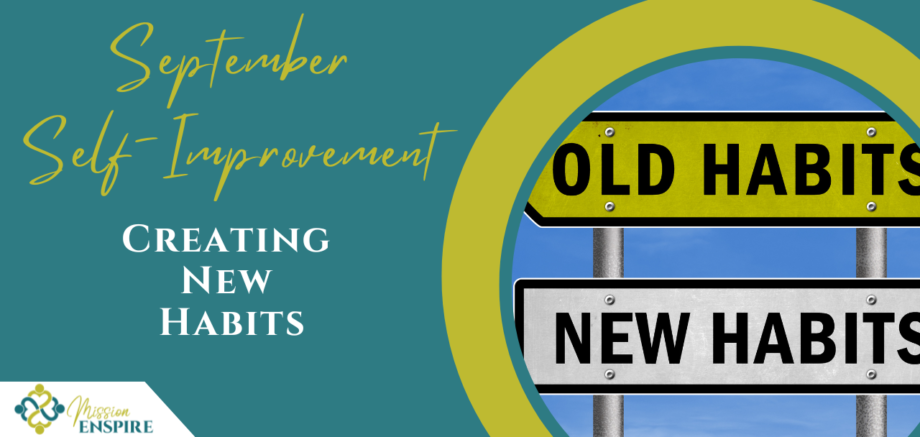Welcome back to the Flourishing Fiercely blog! I enjoyed taking the last week of August to recharge a bit and gear up for September, and I hope you all had a chance to fit in some self-care time as well. Now that September is here, a new school year is fully up and running—but that “back to school” spirit doesn’t have to be just for kids and their parents. I’m a firm believer in lifelong learning, and even if we aren’t school-aged or returning to a traditional classroom, we can still continue our “schooling” in ways that are meaningful, enriching, and fit into our adult lives.
Not all learning is academic. In fact, self-improvement is an important aspect of lifelong learning; it involves learning about ourselves, developing awareness and being attuned to ourselves, and taking action to change or improve the things about our lives that help us achieve our goals and overall satisfaction. As it happens, September is also Self-Improvement Month, so I’m excited to talk about the concept of self-improvement in this month’s blog series. This week, I’ll be focusing on an important factor that ties into our self-improvement journey: habits. Habits are things that we do on a regular basis, enough so that they feel more like second nature to us than something we’re making a concerted effort to do. These habits, in turn, are what helps us support and maintain our self-improvement goals, whatever those may be.
Three Steps to Creating New Habits
We all have times in our lives where we intentionally want to change our behavior for the better and create new habits for ourselves. This could be getting in the habit of eating healthier and drinking more water. Or it could be moving more and taking the dog for a daily walk. Or it could be work related, or spiritual, or… There are so many areas in our lives that could be improved and made easier if we created new habits.
Getting into the habit of doing something is often easier said than done. As with many other areas of life, making changes to our habits can be challenging. I want to take a moment here to note that when I talk about habits, I’m intentionally avoiding labeling them as “good” or “bad.” It’s common to see habits categorized this way—in content about health, wellness, personal finance, and many other areas—but as a coach who’s committed to a nonjudgmental approach, I generally don’t think this labeling is helpful. It’s not for me or anyone else to deem a habit “good” or “bad,” instead it’s up to you to decide whether a habit that you have is serving you or standing in your way, and whether and how you might want to change it or set a new habit.
So, getting back to creating new habits: let’s break it down into a three-step process that makes it easy to follow until we’ve internalized the new behavior and made it a true habit – something we do automatically without having to think about, like brushing our teeth.
- Decide What You Want To Do. The first step is to decide what you want that new habit to be. Be as specific as possible. Don’t just tell yourself you want to move more. Instead say something like “I will go for a 30 minute walk every single day.” (If this sounds familiar, that’s because it draws on the “S” in SMART goals that we discussed in a blog series earlier this year, and as with goal-setting, specificity in habit-setting is key.) Deciding what your new habit will be and committing to when and how you’re going to do it, is half the battle.
- Remind Yourself To Get It Done. The next few days should be smooth sailing. You’re motivated and excited to get this done. Sticking to your new habit isn’t an issue. But a few days in you’ll notice that it’s easy to slip back into old habits. Maybe it’s raining and you don’t really want to go out and walk. Or maybe your day just gets away from you. This is when it’s important to have a daily reminder. Set an alert on your phone or add the new habit to your daily to-do list for a while.
- Make It Part Of Your Routine Until It Becomes A Habit. Which brings us to the last step. It takes some time before a new behavior becomes a true habit. Until then, a routine will work to your best advantage. Even before the new behavior becomes automatic, a routine will help you get it done without having to spend a lot of willpower or relying on daily reminders. Make that daily walk part of your after-dinner routine.
The Inverse Relationship Between Habits and Willpower
It can be hard to keep up willpower, especially when trying to set a new habit, or when that habit involves doing some things we aren’t that excited about in the moment—but that we know will benefit us and our goals in the long term. But what about getting up to take the kids to school every morning, brushing our teeth or going to work every day. Those may not be our favorite things to do either, but we do them daily without the risk of running out of willpower.
That’s because they have become habits. They are so ingrained in what we do and who we are that we do them without even considering skipping a day or a week. We don’t have to make a conscious decision each day to shower or drive to work. It’s just what we do – a habit. When you start to think about it, there is an inverse relationship between habits and willpower. When you first want to build a new habit, it takes a lot of willpower to get it done day in and day out. As you start to establish that habit, it becomes easier and easier to do until you don’t even have to think about it anymore.
While we’re in that transition from willpower to habit, we can use tools to make it easier. Use a to-do list or set a reminder to help stay on track. Find an accountability partner—another tactic that also helps with longer-term goal-setting–so the two of you can motivate each other and help bolster that willpower when it starts to fade after the first enthusiasm wears off. Even something as simple as laying out your clothes the night before and keeping your sneakers by the door will make it a little easier to go out for that walk or run, for example. Do what you can to help your willpower along until you have made the new behavior a true habit. After that it’ll be easy and automatic and you’ve created a new lifelong habit.
How Long Does It Really Take To Create A New Habit?
You might have heard the common saying that it takes 21 days to form a new habit—but that’s kind of an odd and arbitrary timeframe, isn’t it? So how long does it really take to create a new habit? The answer is that it depends. Everyone’s situation is different, and I’m not a fan of attaching one-size-fits-all timeframes to new habit-creation, since that runs the risk of causing us to put pressure on ourselves or feel guilty if we haven’t embraced a new habit by someone else’s random deadline
It can also depend on how big of a change you’re making in moving from your old habit to the new one. If it’s your habit to go to bed at midnight and you want to make a new habit of being in bed by 11:00pm, for example, it might not take long to make that relatively small change. But if you’re looking to move toward, say, a 9:00pm bedtime, that might be more challenging and take longer (especially for folks who have caregiving or other home responsibilities that take up time in the evenings after work).
When we ask that question, what we really want to know is how long do we have to tough it out before it gets easier? Is there a light at the end of the tunnel where we don’t have to try so hard anymore? In other words, when will this new behavior become automatic?
While it will be different from one person to the next and even from one habit to the next, there are a few things to keep in mind. It’s easier to make a new habit than get rid of an old one. Be prepared to work a lot harder to give up checking your email every two minutes, if you’re trying to get out of the habit of being so tethered to your computer or mobile device. Whenever possible, try to replace an old habit with a new one. For example if you’re wanting to give up coffee, brew a cup of herbal tea in the morning and throughout the day when you would usually reach for your cup of joe.
Habits will form faster if you stick to the same time and environment each day. Instead of going for a walk whenever, keep your sneakers next to the door and schedule your walk every day at 6pm, right after dinner for example. A constant reminder of why you’re trying to change your behavior is also helpful. Remind yourself every day that you’re exercising so your body stays strong, and you can go play with the kids or grandkids in the yard. Or that you’re cutting down on TV-watching or social media-scrolling time so that you can make faster headway on your market research and drafting a business plan for that entrepreneurial venture you’ve been dreaming of for years. Yes, it will take some time to make new habits and replace old ones. But it will be well worth it in the end.
While it will be differI hope these tips on creating new habits will be helpful and inspiring to you! (I’ve used these myself and continue to use them as I make new habits of my own.) Next week, I’ll be back to discuss how to optimize our strengths (yes, we all have them, even if there are times where we’re in a rut and it’s hard to recognize our strengths!) in service of our self-improvement goals.


Wow! This was informative as well as enlightening. I am one of those who gets overwhelmed when it comes to completing a task, such as cleaning out my closet. However, after reading this article it helps me to understand that if I make this task of cleaning my closet a habit on a consistent basis it will not be so overwhelming. For example, cleaning the closet every three months would lessen the stress.
Thanks Tara, I’m glad you found this helpful and hopefully you are able to create some new habits that will serve you well.